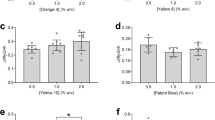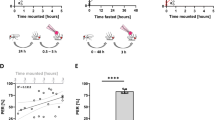Abstract
Food intake is a fundamental parameter in animal studies. Despite the prevalent use of Drosophila in laboratory research, precise measurements of food intake remain challenging in this model organism. Here, we compare several common Drosophila feeding assays: the capillary feeder (CAFE), food labeling with a radioactive tracer or colorimetric dye and observations of proboscis extension (PE). We show that the CAFE and radioisotope labeling provide the most consistent results, have the highest sensitivity and can resolve differences in feeding that dye labeling and PE fail to distinguish. We conclude that performing the radiolabeling and CAFE assays in parallel is currently the best approach for quantifying Drosophila food intake. Understanding the strengths and limitations of methods for measuring food intake will greatly advance Drosophila studies of nutrition, behavior and disease.
This is a preview of subscription content, access via your institution
Access options
Subscribe to this journal
Receive 12 print issues and online access
$259.00 per year
only $21.58 per issue
Buy this article
- Purchase on Springer Link
- Instant access to full article PDF
Prices may be subject to local taxes which are calculated during checkout




Similar content being viewed by others
References
Carvalho, G.B., Kapahi, P. & Benzer, S. Compensatory ingestion upon dietary restriction in Drosophila melanogaster. Nat. Methods 2, 813–815 (2005).
Grandison, R.C., Piper, M.D. & Partridge, L. Amino-acid imbalance explains extension of lifespan by dietary restriction in Drosophila. Nature 462, 1061–1064 (2009).
Heilbronn, L.K. & Ravussin, E. Calorie restriction and aging: review of the literature and implications for studies in humans. Am. J. Clin. Nutr. 78, 361–369 (2003).
Ja, W.W. et al. Water- and nutrient-dependent effects of dietary restriction on Drosophila lifespan. Proc. Natl. Acad. Sci. USA 106, 18633–18637 (2009).
Lee, K.P. et al. Lifespan and reproduction in Drosophila: New insights from nutritional geometry. Proc. Natl. Acad. Sci. USA 105, 2498–2503 (2008).
Min, K.J. & Tatar, M. Restriction of amino acids extends lifespan in Drosophila melanogaster. Mech. Ageing Dev. 127, 643–646 (2006).
Broughton, S.J. et al. DILP-producing median neurosecretory cells in the Drosophila brain mediate the response of lifespan to nutrition. Aging Cell 9, 336–346 (2010).
Driver, C.J.I., Wallis, R., Cosopodiotis, G. & Ettershank, G. Is a fat metabolite the major diet dependent accelerator of aging? Exp. Gerontol. 21, 497–507 (1986).
Mair, W., Piper, M.D. & Partridge, L. Calories do not explain extension of life span by dietary restriction in Drosophila. PLoS Biol. 3, e223 (2005).
Edgecomb, R.S., Harth, C.E. & Schneiderman, A.M. Regulation of feeding behavior in adult Drosophila melanogaster varies with feeding regime and nutritional state. J. Exp. Biol. 197, 215–235 (1994).
Wood, J.G. et al. Sirtuin activators mimic caloric restriction and delay ageing in metazoans. Nature 430, 686–689 (2004).
Ayaki, T., Oshima, K. & Yoshikawa, I. Linear relationship between lethal mutation yield and intake of ethyl methanesulfonate in Drosophila melanogaster. Environ. Mutagen. 7, 147–153 (1985).
Brummel, T., Ching, A., Seroude, L., Simon, A.F. & Benzer, S. Drosophila lifespan enhancement by exogenous bacteria. Proc. Natl. Acad. Sci. USA 101, 12974–12979 (2004).
Carvalho, G.B., Kapahi, P., Anderson, D.J. & Benzer, S. Allocrine modulation of feeding behavior by the Sex Peptide of Drosophila. Curr. Biol. 16, 692–696 (2006).
Geer, B.W., Olander, R.M. & Sharp, P.L. Quantification of dietary choline utilization in adult Drosophila melanogaster by radioisotope methods. J. Insect Physiol. 16, 33–43 (1970).
Thompson, E.D. & Reeder, B.A. Method for selecting exposure levels for the Drosophila sex-linked recessive lethal assay. Environ. Mol. Mutagen. 10, 357–365 (1987).
Thompson, E.D., Reeder, B.A. & Bruce, R.D. Characterization of a method for quantitating food consumption for mutation assays in Drosophila. Environ. Mol. Mutagen. 18, 14–21 (1991).
Zeng, C. et al. Gender-specific prandial response to dietary restriction and oxidative stress in Drosophila melanogaster. Fly (Austin) 5, 174–180 (2011).
Wong, R., Piper, M.D., Blanc, E. & Partridge, L. Pitfalls of measuring feeding rate in the fruit fly Drosophila melanogaster. Nat. Methods 5, 214–215, author reply 215 (2008).
Ewing, L.S. & Ewing, A.W. Courtship of Drosophila melanogaster in large observation chambers: the influence of female reproductive state. Behaviour 101, 243–252 (1987).
Wong, R., Piper, M.D., Wertheim, B. & Partridge, L. Quantification of food intake in Drosophila. PLoS ONE 4, e6063 (2009).
Ja, W.W. et al. Prandiology of Drosophila and the CAFE assay. Proc. Natl. Acad. Sci. USA 104, 8253–8256 (2007).
Vigne, P. & Frelin, C. Food presentation modifies longevity and the beneficial action of dietary restriction in Drosophila. Exp. Gerontol. 45, 113–118 (2010).
Catterson, J.H. et al. Dietary modulation of Drosophila sleep-wake behaviour. PLoS ONE 5, e12062 (2010).
Chatterjee, A., Tanoue, S., Houl, J.H. & Hardin, P.E. Regulation of gustatory physiology and appetitive behavior by the Drosophila circadian clock. Curr. Biol. 20, 300–309 (2010).
Xu, K., Zheng, X. & Sehgal, A. Regulation of feeding and metabolism by neuronal and peripheral clocks in Drosophila. Cell Metab. 8, 289–300 (2008).
Sellier, M.J., Reeb, P. & Marion-Poll, F. Consumption of bitter alkaloids in Drosophila melanogaster in multiple-choice test conditions. Chem. Senses 36, 323–334 (2011).
Devineni, A.V. & Heberlein, U. Preferential ethanol consumption in Drosophila models features of addiction. Curr. Biol. 19, 2126–2132 (2009).
Al-Anzi, B. et al. Obesity-blocking neurons in Drosophila. Neuron 63, 329–341 (2009).
Fanson, B.G., Yap, S. & Taylor, P.W. Geometry of compensatory feeding and water consumption in Drosophila melanogaster. J. Exp. Biol. 215, 766–773 (2012).
Barnes, A.I., Wigby, S., Boone, J.M., Partridge, L. & Chapman, T. Feeding, fecundity and lifespan in female Drosophila melanogaster. Proc. Biol. Sci. 275, 1675–1683 (2008).
Bruce, K.D. et al. High carbohydrate-low protein consumption maximizes Drosophila lifespan. Exp. Gerontol. 48, 1129–1135 (2013).
O'Brien, D.M., Min, K.J., Larsen, T. & Tatar, M. Use of stable isotopes to examine how dietary restriction extends Drosophila lifespan. Curr. Biol. 18, R155–R156 (2008).
Min, K.J., Hogan, M.F., Tatar, M. & O'Brien, D.M. Resource allocation to reproduction and soma in Drosophila: a stable isotope analysis of carbon from dietary sugar. J. Insect Physiol. 52, 763–770 (2006).
Sury, M.D., Chen, J.X. & Selbach, M. The SILAC fly allows for accurate protein quantification in vivo. Mol. Cell. Proteomics 9, 2173–2183 (2010).
Xu, P. et al. Stable isotope labeling with amino acids in Drosophila for quantifying proteins and modifications. J. Proteome Res. 11, 4403–4412 (2012).
Acknowledgements
We thank M. Piper and L. Partridge (University College London) for the Dahomey fly line and K.D. Bruce, R. Yamada and K.R. Murphy (The Scripps Research Institute) for comments on the manuscript. This work was supported by grants from the US National Institutes of Health (R00AG030493 and R21DK092735), an Ellison Medical Foundation New Scholar in Aging award and a Glenn Foundation for Medical Research Award for Research in Biological Mechanisms of Aging (W.W.J.).
Author information
Authors and Affiliations
Contributions
All authors designed and carried out experiments. S.A.D., G.B.C., A.A., A.M.P., S.H. and W.W.J. also analyzed data and wrote the paper.
Corresponding author
Ethics declarations
Competing interests
The authors declare no competing financial interests.
Supplementary information
Supplementary Text and Figures
Supplementary Figures 1–7 (PDF 2276 kb)
Rights and permissions
About this article
Cite this article
Deshpande, S., Carvalho, G., Amador, A. et al. Quantifying Drosophila food intake: comparative analysis of current methodology. Nat Methods 11, 535–540 (2014). https://doi.org/10.1038/nmeth.2899
Received:
Accepted:
Published:
Issue Date:
DOI: https://doi.org/10.1038/nmeth.2899
This article is cited by
-
Neuronal knockdown of Cullin3 as a Drosophila model of autism spectrum disorder
Scientific Reports (2024)
-
Exposure to polystyrene microplastic beads causes sex-specific toxic effects in the model insect Drosophila melanogaster
Scientific Reports (2023)
-
Sexual identity of enterocytes regulates autophagy to determine intestinal health, lifespan and responses to rapamycin
Nature Aging (2022)
-
Identification of additional dye tracers for measuring solid food intake and food preference via consumption-excretion in Drosophila
Scientific Reports (2022)
-
Fluorescent silica nanoparticles as an internal marker in fruit flies and their effects on survivorship and fertility
Scientific Reports (2022)



